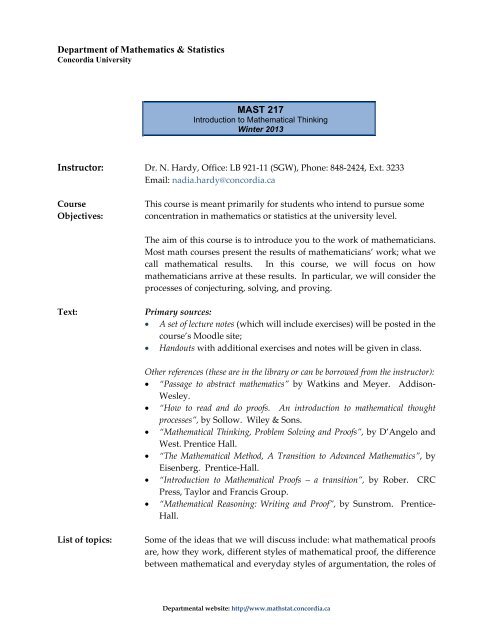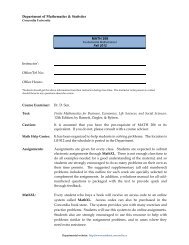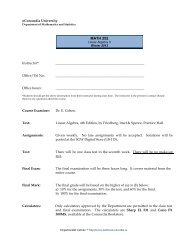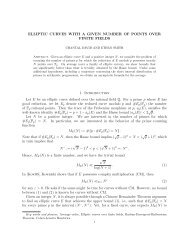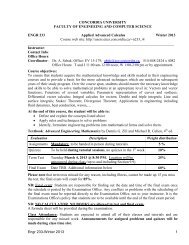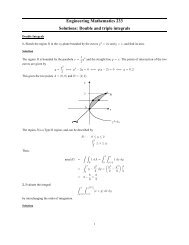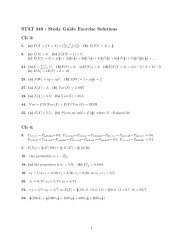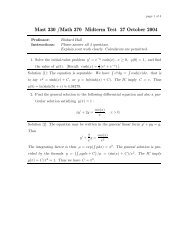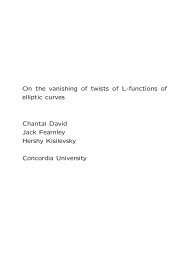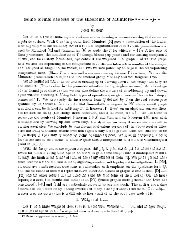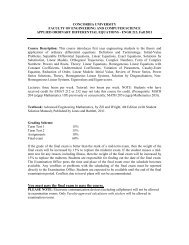MAST 217 - Department of Mathematics and Statistics - Concordia ...
MAST 217 - Department of Mathematics and Statistics - Concordia ...
MAST 217 - Department of Mathematics and Statistics - Concordia ...
Create successful ePaper yourself
Turn your PDF publications into a flip-book with our unique Google optimized e-Paper software.
<strong>Department</strong> <strong>of</strong> <strong>Mathematics</strong> & <strong>Statistics</strong><strong>Concordia</strong> University<strong>MAST</strong> <strong>217</strong>Introduction to Mathematical ThinkingWinter 2013Instructor: Dr. N. Hardy, Office: LB 921‐11 (SGW), Phone: 848‐2424, Ext. 3233Email: nadia.hardy@concordia.caCourseObjectives:This course is meant primarily for students who intend to pursue someconcentration in mathematics or statistics at the university level.The aim <strong>of</strong> this course is to introduce you to the work <strong>of</strong> mathematicians.Most math courses present the results <strong>of</strong> mathematicians’ work; what wecall mathematical results. In this course, we will focus on howmathematicians arrive at these results. In particular, we will consider theprocesses <strong>of</strong> conjecturing, solving, <strong>and</strong> proving.Text:Primary sources: A set <strong>of</strong> lecture notes (which will include exercises) will be posted in thecourse’s Moodle site; H<strong>and</strong>outs with additional exercises <strong>and</strong> notes will be given in class.Other references (these are in the library or can be borrowed from the instructor): “Passage to abstract mathematics” by Watkins <strong>and</strong> Meyer. Addison‐Wesley. “How to read <strong>and</strong> do pro<strong>of</strong>s. An introduction to mathematical thoughtprocesses”, by Sollow. Wiley & Sons. “Mathematical Thinking, Problem Solving <strong>and</strong> Pro<strong>of</strong>s”, by D’Angelo <strong>and</strong>West. Prentice Hall. “The Mathematical Method, A Transition to Advanced <strong>Mathematics</strong>”, byEisenberg. Prentice‐Hall. “Introduction to Mathematical Pro<strong>of</strong>s – a transition”, by Rober. CRCPress, Taylor <strong>and</strong> Francis Group. “Mathematical Reasoning: Writing <strong>and</strong> Pro<strong>of</strong>”, by Sunstrom. Prentice‐Hall.List <strong>of</strong> topics:Some <strong>of</strong> the ideas that we will discuss include: what mathematical pro<strong>of</strong>sare, how they work, different styles <strong>of</strong> mathematical pro<strong>of</strong>, the differencebetween mathematical <strong>and</strong> everyday styles <strong>of</strong> argumentation, the roles <strong>of</strong><strong>Department</strong>al website: http://www.mathstat.concordia.ca
MATH <strong>217</strong> – Winter 2013Page 2definitions, assumptions, examples <strong>and</strong> counter‐examples inmathematical pro<strong>of</strong>, <strong>and</strong> different problem solving techniques.To illustrate these ideas we will consider mathematics that should befamiliar to you (such as elementary notions about the real numbersystem, geometry, <strong>and</strong> functions) <strong>and</strong> some mathematics that you mightnot be familiar with (such as the notions <strong>of</strong> equivalence <strong>and</strong> orderrelations, <strong>and</strong> cardinality).Grading:The following grading scheme will be used: Homework/Assignments: 30% Four in‐class quizzes: 40% (10% each) Final examination: 30%Note: There is no “100% final option” in this course. It is absolutelynecessary to do the homework, assignments <strong>and</strong> quizzes.


